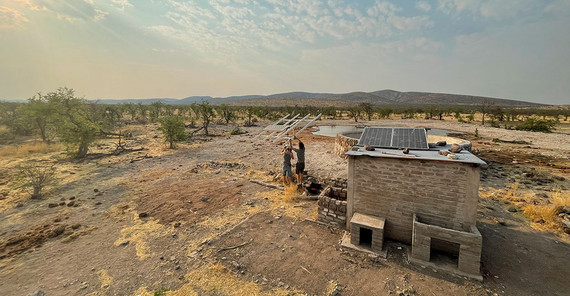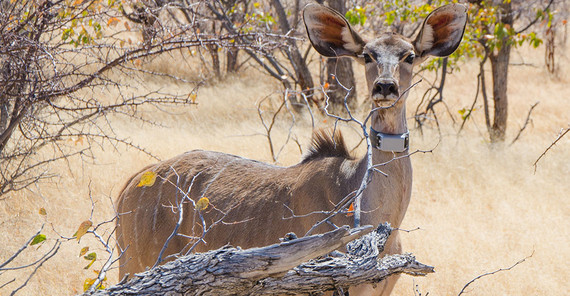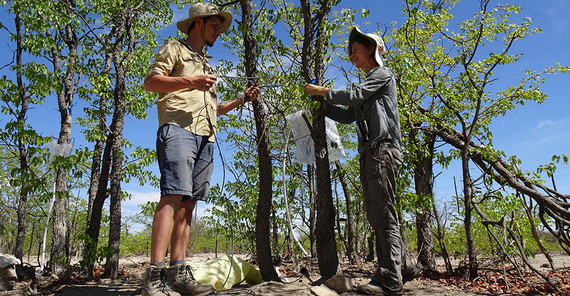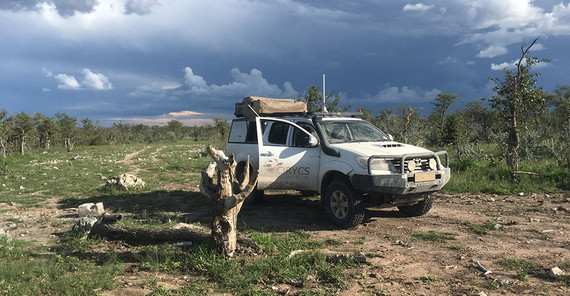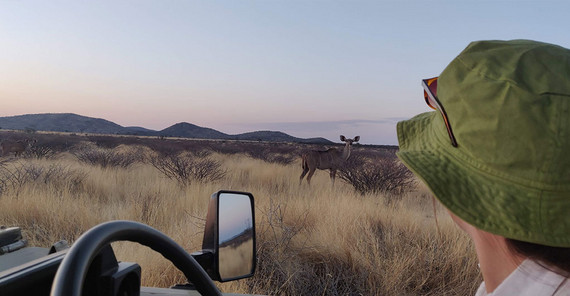In many places in Africa, the same problem prevails: the intensive use of large areas for grazing commercial livestock damages the land. It is degrading, as biologists say. Grass and trees that used to share the savanna are being displaced by thorny bushes and shrubs. As a result, the land is not only lost to livestock farming, it is also ecologically impoverished.
Since 2014, researchers from Potsdam have been searching for the causes of this development and for ways to stop and, at best, reverse it. “The widespread land degradation in Namibia has brought farmers and scientists together,” explains ecologist Dr. Niels Blaum. When grasslands become overgrown, farmers and many other people lose their means of existence: Their animals can no longer find enough food. But the decline in grassland also has other consequences. Where the sward no longer protects the soil, it erodes more easily. The rain flows off the surface, and less of it seeps into the ground. Groundwater balance, nutrient cycles, and species composition change. The entire ecosystem is affected.
Ecological balance is the goal
Ironically, those that have been more or less expelled from their homes in many places over the past decades could now help: wild animals. “They are much better adapted to the climate and even to its changes than ‘imported’ farm animals and can contribute to the preservation of biodiversity,” says Blaum. This requires a change in thinking, which has been taking place in Namibia for some time. “The country has realized the value of indigenous wildlife.” The issue is a priority at the political level, and the second National Biodiversity Strategy and Action Plan was recently published. Moreover, about 35% of Namibia’s land area – known as conservancies – are already being used for or by wildlife. “But wildlife management is a challenge,” Blaum says. “During a drought, you can’t just load the animals onto a truck and take them to a safe place. You have to solve the problem locally and prepare accordingly.”
So far, the effects of keeping more wild animals instead of livestock on the savanna ecosystem were unclear, says Niels Blaum. In order to investigate whether wildlife management is suitable for the sustainable use of savannas, the Potsdam researchers and their German and Namibian partners have launched the ORYCS project, which is led by Niels Blaum. “So far there haven’t been any studies on whether it is better than the previously dominant livestock husbandry,” he says. “For this reason, we analyzed the different types of use and how they can be optimized.” How does settling wild, often diverse, animals affect vegetation? How do vegetation and water balance develop in areas with large springbok, kudu, or eland populations? How is climate change affecting the interaction of all these factors? Can humans ensure a stable ecological balance locally? The researchers had to answer these varied questions to understand this complex system. That is why the team included researchers from a wide range of disciplines such as wildlife ecology, vegetation ecology, hydrogeology, geological remote sensing, and social ecology.
New possibilities due to GPS transmitters
The Potsdam researchers coordinated the whole project and worked on four of six work packages. During the fieldwork phases, they collected data together with the Namibian partners. They tagged animals and plants with transmitters, measured water fluxes and biomass in predefined areas, conducted experiments on different vegetation systems and registered the investigated areas with state-of-the-art remote sensing technology.
Blaum not only led ORYCS but, for one subproject, also analyzed where the wild animals stay and how they move. The investigated area was Etosha Heights, one of the largest private reserves in Namibia. Springbok, kudu, eland, and giraffe: The ecologist and his team equipped a total of 60 animals with GPS transmitters. These measure their exact position and acceleration every five minutes. This makes it possible to track the animals’ movements and also draw conclusions about their use of energy and behavior. When do they eat? When do they rest or flee, and when do they cover longer distances? “We wanted to know what influences their movements and when,” Blaum explains. “What is the effect of searching for food and water, climatic conditions but also man-made changes such as fences?” Since 2019, over two million GPS localizations and four million activity records have been collected. The animals travelled a total of 130,000 kilometers on 13,500 recorded days. Each of the animals with transmitters, captured at a different location in the investigated area, represents an entire group. Thus, the data ultimately provide information about far more than just 60 animals.
Due to the long period of measurements, which also included several dry and rainy seasons, the researchers were able to demonstrate how much the animals adapt to the climatic conditions: During the dry season, they move less, staying relatively close to the easily accessible water points. With the start of the rainy season, however, when the vegetation sprouts and there is plenty of food, they start moving and cover long distances. To determine where they move, the researchers also analyzed satellite images. They analyzed the spectra of the images, that is, the characteristic composition of the light from spectral colors. They were thereby able to show that the animals don’t wander around aimlessly but look for and find the greenest, and thus best, feeding places during their so-called migratory movements.
Climate change also afflicts wildlife
Nevertheless, the adaptability of wildlife also has its limits. “When temperatures rise to extremes, all species become less active,” Blaum says. They move less and seek the shade of trees when it is very hot. “As a result, they may no longer be able to cover their basic needs.” To investigate this question, the researchers compared the movement profiles of the animals on the ten hottest and ten coolest days in the warmest months of the year. “Springboks, for example, do not manage to compensate for the lack of activity,” he says. In other words, they suffer from the heat and have too little time to eat enough food. “Eland antelopes, on the other hand, make up for it at night.” As temperatures continue to rise, this could, in turn, give them a decisive advantage in the competition among species and be taken into account in wildlife management.
Another important aspect only emerged in the course of the project: the influence that humans still have on animals even in protected zones. A veterinary fence runs through Etosha Heights, which is intended to prevent the introduction of foot-and-mouth disease into the south. Although the fence is two and a half meters high and safe for wildlife, it cannot withstand elephants breaking through, so there are always holes. Other species also look for and find these holes, as the movement profiles of the tagged animals showed. A look at the data, however, revealed a very disturbing finding: the fence puts the animals under stress. During the so-called “crossing events” - when they are looking for gaps in the fence, using them and slipping through, but also afterwards - depending on the species, the animals spend 12-15% more energy than normally. “This finding definitely creates a stir politically,” says Blaum. Especially since the fence, if damaged, only serves its purpose incompletely anyway. There is currently a discussion about the possibility of installing gates with mobile monitoring so that elephants, for example, could be automatically recognized and could then pass.
From small to big models
In additional subprojects, the researchers looked at the plants to determine how wildlife and vegetation mutually affect each other in the savanna. “The wild animals feed on bushes and trees, even on new seedlings. Cattle don’t do that at all,” Blaum says. “Because many bushes are 'armed' with thorns or store poorly digestible substances in their leaves.” So wildlife is more likely to help keep bush encroachment in check or even reduce it.
Some effects of wildlife management can, to a large extent, be determined directly. For example, a comparison of the water quality of 68 water points in different areas showed that the quality is significantly better in national parks with long-standing wildlife management than where farm animals are kept. “Wild animals come to the watering hole, drink and leave again,” Blaum explains. “Cattle stay by the water and thereby contaminate it themselves.”
And the soil also “benefits” from the presence of wildlife. The researchers analyzed the soil in areas where springbok, kudu, and eland were active in large herds and found that it contained more nitrogen and carbon than in other places. Essentially, litter and excrement fertilize the soil, and the animals loosen it with their hooves. “They themselves create good conditions for plant growth,” Blaum says.
Since wildlife in the conservancies is settled and kept by humans, ORYCS was intended to clarify as precisely as possible who “gets along” with whom. “The grazing pressure of the wild animals influences the architecture of the trees and thus also the entire water balance of the areas,” explains Dr. Katja Geißler. The ecologist investigates the water flows in the savanna. To reconstruct this complex system, the researchers combined different methods. They recorded the vegetation in selected typical areas, for example. To do so, they also received help from other disciplines, such as from the Potsdam geoscientist Prof. Bodo Bookhagen, who contributed his expertise in “eco-hydrogeomorphic remote sensing”. By analyzing satellite and drone images of the region, the researchers scaled the determined biomass for the entire study area. They recorded the soil moisture and fitted selected trees with sensors that indicate where more or less water is flowing. To be able to determine grazing by wild animals, some of the trees studied were partly artificially defoliated. “By comparing trees that have been grazed to different extents, we can see what influence grazing pressure has on the water balance of the trees and the water flows,” she says. All measurements were ultimately brought together to map the “cross-scale water flows” and to combine them with the studies on plant biodiversity. For this so-called “ecohydrological modelling of plant diversity”, the Potsdam researchers cooperated with a team of colleagues from Freie Universität Berlin led by Prof. Britta Tietjen.
In the end, the researchers developed three different models into which the collected data were fed and with the help of which different processes were to be simulated. The two larger-scale models were developed in Potsdam under the direction of Prof. Florian Jeltsch and Dr. Dirk Lohmann. The smallest model was developed at the FU Berlin, and while it simulates an area of only 25 hectares, it has a temporal resolution of one hour to one day. “It is used, for example, to simulate water flows that change as animals graze.” The medium model has the size of a typical land use unit, such as a farm of 5,000 hectares, and takes into account larger time intervals. The researchers have used it to study, for example, how biomass production changes with increasing wildlife grazing. “This enables us to determine quite well which herd composition is particularly favorable for avoiding scrub encroachment,” says Dr. Dirk Lohmann, who worked on the model with Blaum. Without browsing animals, i.e. wild animals that feed on leaves, the areas start to turn into bushland. “If we increase the proportion of these browsing animals, this dynamic can be mitigated. But if they make up more than 40%, they damage the balance of the system.” The same simulation is also possible for herds that feed predominantly on grass (so-called grazers) – and mixed feeders – those that eat both leaves and grass. “In this way, ideal compositions of wildlife populations can be determined for different vegetation types,” she explains.
In the largest of the three models, which covers an entire region of up to 100,000 hectares, the ORYCS makers simulate the complex functional structure of the ecosystem over longer periods of time. “It provides us with an overview,” Blaum says. “We are integrating GPS data from our animals with transmitters and looking at how degradation can be pushed back or prevented on a large scale.” To do this, the researchers are experimenting virtually with specific herd compositions and purposefully placed water points. “The first simulations show that areas that have become overgrown can be restored locally in this way and that the areas covered by bush will decrease significantly in 50 years.”
Taking findings to the savanna
With the results of four years of work in their files, Niels Blaum and his colleagues set out in October 2022 to meet those they are supposed to help: those responsible for Namibian national parks, farmers, politicians, conservationists, and ministry officials. “We presented our findings at an initial roadshow,” says the researcher. “The farmers were extremely interested and at the national park, they wanted to keep our presentation posters.” The researchers are currently developing information materials to prepare their findings for the various actors in a concise but suitable manner. This is where the Institute for Social-Ecological Research (ISOE), led by Dr. Stefan Liehr, contributes its expertise.
For Blaum, however, the work in Namibia does not end there. After all, the animals fitted with a transmitter in 2019 are still providing data – and these are constantly raising new questions. “Just when we think we have understood everything, something new comes up,” the ecologist says excitedly. Thanks to the good cooperation with the Namibian partners, the Potsdam researchers continue to receive movement profiles and will be able to evaluate them in the future. For Blaum, in any case, the journey through the savanna will continue.
The Project
ORYCS – Option for sustainable land use adaptations in savanna systems: Chances and risks of emerging wildlife-based management strategies under regional and global change
Participants: University of Potsdam (coordinator), Namibia University of Science and Technology, Freie Universität Berlin, University of Namibia, Institute for Social-Ecological Research, Ministry of Environment and Tourism Namibia
Duration: 2019–2023
Funding: Federal Ministry of Education and Research (BMBF)
The Researchers
PD Dr. Niels Blaum studied biology in Nice and Frankfurt/Main. Since 2004, he has been research assistant at the Plant Ecology and Nature Conservation Chair of the University of Potsdam.
Mail: niels.blaumuuni-potsdampde
Dr. Katja Geißler studied biology in Berlin and Aberystwyth. Since 2009, she has been research assistant at the Plant Ecology and Nature Conservation Chair of the University of Potsdam.
Mail: katja.geissler.iiiuuni-potsdampde
Dr. Dirk Lohmann studied biology in Ulm and Potsdam. Since 2012, he has been post-doctoral research fellow at the Plant Ecology and Nature Conservation Chair.
Mail: dirk.lohmannuuni-potsdampde
This text was published in the university magazine Portal Wissen - Eins 2023 „Lernen“ (PDF).

